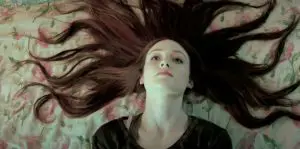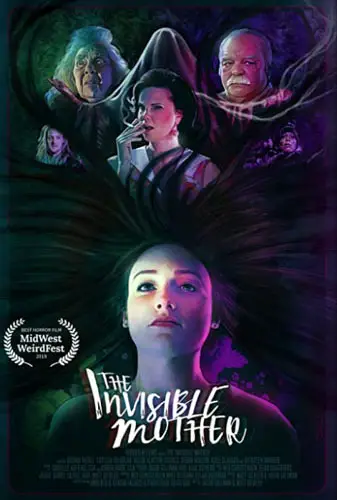
Some stoners like their butterflies to have death heads, so if spooky is your smoking jazz, then get on the groovy ghoulie train that is co-writers/co-directors Matthew Diebler and Jacob Gillman’s psychedelic haunter The Invisible Mother. Your eyes will eat up the trippy visuals like potato chips, and your lungs will shiver in happiness. Grab a vial of the top-shelf herb cause this cookie will chew you up! For anyone still left, we will now turn to a more academic appreciation of this impressive debut, mainly dealing with retro Italian cinema flourishes.
Stoner Marcy (Fayelyn Bilodeau) has left behind her gig in an orchestra and her girlfriend to move back to her hometown. Unfortunately, Grandma Mona (Helen Slayton-Hughes) has Alzheimer’s, and Grandpa Archie (Richard Riehle) needs help. Neighbor Coco (Kiersten Warren) is ready to pitch in with a bunch of knick-knacks from a yard sale, including a book of Victorian children photos, to brighten up the place. Once settled, Marcy starts getting her weed from ice cream truck driver Wyatt (Kale Clauson).
As the days tick by, Mona starts acting more and more erratic, claiming to see people in empty rooms and hear voices over busy signals on the telephone. Archie tells her it is just the disease, but soon Marcy also starts seeing ghastly figures and hearing voices. Good thing Coco is studying to be a medium under renowned psychic Glorianna (Debra Wilson). She can use her budding powers against any restless spirits. Except these spirits are the scariest ghosts since The Shining, specifically those creepy animal mask ones in the corners at the end. Soon Marcy is burning sage as well as marijuana because Mona isn’t crazy, and the ghosts are closing in.

“…Marcy also starts seeing ghastly figures and hearing voices.”
Right from the stellar throwback opening credit sequence, The Invisible Mother plants its style in the vein of the Giallo subgenre. These pictures pushed the envelope for visual innovation by using bright primary colors for unreal lighting choices and pulsing music, even if they were slashers. What is intriguing about the filmmakers’ homage is that they utilize the look, sound design, and lighting of the genre but leave behind the story conventions altogether. No cops in trench coats with mustaches chasing killers with black gloves are present. Instead, Diebler and Gillman have applied this beloved horror style to a ghost story, and it works wonders.
The setting is brilliantly rendered by the production design of Gillman. His devotion to the textures of 20th-century kitsch approaches the heights reached by Anna Biller, while the new wave set design echoes the best of Rinse Dream. It goes without saying that the entire production is very pretty and perfect to smoke grass during. It takes a few minutes for the trippiness to kick in, but the deceptively simple setup is just a trap for the jaw drop that awaits.
The marketing for The Invisible Mother goes out of its way to make sure it is understood Marcy is a member of the LGBTQIA+ community, which comes up a couple of times but is neither sensationalized nor core to the plot. This adds to the impact of this incredibly fabulous cult-in-waiting flick, as it definitely lands in the weird end of the horror pool. The practical special effects are a wonder to behold, reaching back to the power of a truly weird yesteryear.
The narrative almost follows the thought patterns of the stoners in it, starting with baffled foolishness that evolves into inspired brilliance. The unspeakable depths of its horror are only matched by the otherworldly beauty of The Invisible Mother. Medicate Italian style and discover the retro magic within.

"…the unspeakable depths of its horror are only matched by the otherworldly beauty..."



[…] View the full article from FILM THREAT […]